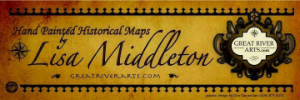Through the Ages, Maps have always been Art
A calligrapher works by candlelight- a single candle that barely lights the room. The night is unusually dark outside, and he tries not to let anxiety consume him. His head is bent inches above the paper and his face is crumpled in concentration. With a small nib, he gently creates calculated arches and swirls to lay out his trademark cartouche for the Expedition of Lewis and Clark’s Discoveries, to be presented to Thomas Jefferson the next day! Sweat is dripping from his forehead because he cannot afford to make a single mistake. Even as a master at his craft an assignment of this caliber is daunting and every line counts. Once the calculated lines are all in place, he starts to decorate the areas with swirls of lines that are supposed to look free and spontaneous. No one knows they are not…he has dedicated years of his life in to sign making, letter writing, and calligraphy. He has practiced for years the subtle maneuvering of the nib to create thick and thin curvatures. Sometimes quickly, and sometimes slowly, the cartographer creates the cartouche with a practiced hand. Before he knows it, the first rays of dawn start to shine through the window.
As an art historian, I get frequently asked ‘why maps are art’. When thinking about mapmakers centuries ago, working on their craft, this is not hard to answer. I usually invite people to have a closer look at an old map and they experience the same deep emotions and esthetic pleasure that art provides. Katharine Harmon, writer of the important map reference work The Map as Art: Contemporary Artists Explore Cartography, argues: “There has always been art in cartography. Maps by definition are utilitarian. Cartographers have long known that deploying artistic skills and techniques can enhance a map’s effect.”
Mapmakers throughout the centuries were not only mathematicians, but also true artists. Its an almost impossible task to represent a three dimensional world on a flat surface. It takes a lot of skills to produce such wonderful pieces, especially considering the limited techniques that were available in earlier times. Cartographers didn’t simply stop by just drawing lines. They painted detailed scenes with figures or historical events, to make the maps look more attractive.
Abraham Cresques, Atlas Catalan (1375), Bibliothèque Nationale de France, montage of all 8 pages.
A fine example of such a hand painted scene is one of the illustrations on the Catalan Atlas, made by Abraham Cresques in 1375. The piece was ordered by John I of Aragon, who wanted to have a map of the Strait of Gibraltar. Religious references are made throughout the map and travel texts are adorned by illustrations. One of the scenes is depicting Marco Polo and his caravan. Written next to it is a travel note by Marco Polo saying: “You must know that those who wish to cross this desert remain and lodge for one whole week in a town named Lop, where they and their beasts can rest. Then they lay in all the provisions they need for seven months.”
Abraham Cresques, Atlas Catalan (1375), Bibliothèque Nationale de France, detail: Marco Polo’s caravan
Interestingly, the relationship between maps and art has changed now. According to Katharine Harmon: Now […] artists are using maps to further their artistic purposes. Artists have found in cartography a rich vein of concepts and imagery to mine.”
Maps are not just any form of art; they are among the most important works in art history. Ask any art historian or antiquary and they will agree. Maps are aesthetic and the perfect representation of old handcraft. They are not just showing borders and countries, but they make the universe come to live with their extraordinary beauty.
I have taken great pride in my practice of painting and restoring historic maps, and designing contemporary maps for the future. I have often thought that there is some kind of a higher calling about my dedication to this art form, and it is a great honor to nurture and celebrate the old maps and design new maps that will contribute to world exploration and discovery. At the heart of my work is my expression of love for our dear world, our precious human experience. Trials and turmoil are not unique to this country, or this generation. Trials and struggle animate the history of humans, forced us to be curious and to go further and try harder. The art in the maps make the harsh realities of our limitations and conflicts softer, more palatable, and even hopeful.
Thank you for sharing this journey with me my friends!
Purchase your own Lewis and Clark Map today! https://great-river-arts.

No comments yet.